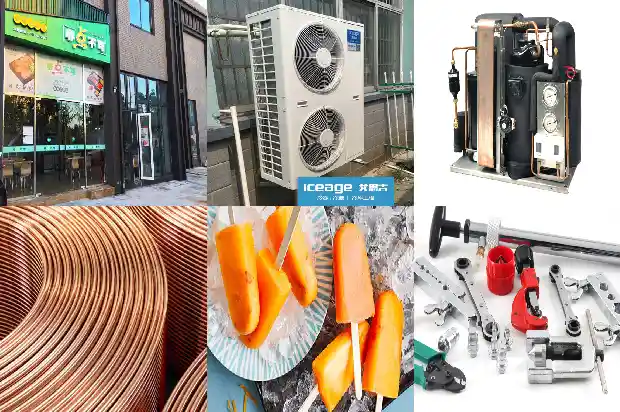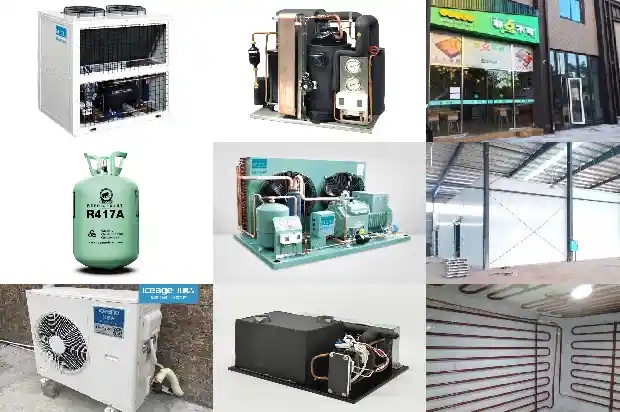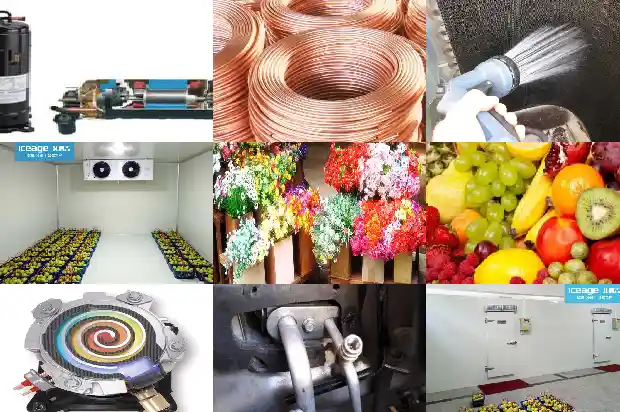What is the difference between ammonia refrigeration and fluorine refrigeration?
2024-09-05
- Refrigerants
- Ammonia refrigerant is an environmentally friendly refrigerant, but its most prominent characteristics are toxicity and explosiveness. Fluorine refrigerants damage the ozone layer. Their greatest advantage is safety and reliability in use.
- Compressors
- 2.1 Ammonia refrigeration units
- Ammonia refrigeration units generally use open reciprocating compressors, open screw compressors, or centrifugal compressors as the main refrigeration hosts. The advantages and disadvantages of this open-type compressor are as follows:
- 2.1.1 Advantages:
- The compressor is relatively separated from the motor, making the compressor more widely applicable.
- The same compressor can adapt to different refrigerants. In addition to using halogenated hydrocarbon refrigerants, by changing the material of some parts, ammonia can be used as a refrigerant.
- Different-capacity motors can be matched according to different refrigerants and operating conditions.
- The refrigeration capacity of a single-head unit can reach about 2 million kcal. The cost is low, and the sales price is relatively cheap.
- 2.1.2 Disadvantages:
- A shaft seal is needed to seal the channels for refrigerant and oil leakage, which is also an object that users often maintain.
- The oil leakage at the shaft seal of an open machine during operation should not be greater than 3 ml/h. Since Freon and refrigeration oil are mutually soluble, the simultaneous leakage of Freon and refrigeration oil during use is inevitable. Especially after 1000 hours of operation, due to the wear of the shaft seal, the leakage of Freon and refrigeration oil will be aggravated, and even affect the normal use of users, thereby increasing the user's maintenance and operating costs.
- The matched motor rotates at a high speed. The airflow noise formed by the cooling fan is large, and the compressor itself also has a large noise, affecting the environment. The noise of an open unit is generally above 85 dB(A).
- A separate oil separator, oil cooler and other complex oil system components need to be configured, making the unit bulky, inconvenient for use and maintenance, heavy in weight, and large in floor area.
- Low efficiency. Due to the need to use an external motor to drive the oil pump and be equipped with an ordinary low-efficiency motor, its efficiency is low. Under the nominal working conditions of air conditioning, the energy efficiency ratio is generally not more than 3.9.
- Since a single compressor is generally used, once a failure occurs, users will be unable to use it. Especially for cold sources for production processes, users will suffer significant losses.
- 2.2 Fluorine refrigeration units
- Fluorine refrigeration units generally use semi-hermetic or fully enclosed compressors, such as scroll compressors, piston compressors, screw compressors, and centrifugal compressors. The advantages and disadvantages of this semi-hermetic compressor are as follows:
- 2.2.1 Advantages:
- Due to the semi-hermetic design, the motor and compressor are integrated, so the noise is low and the vibration is small. There are no problems such as Freon and refrigeration oil leakage in open units, reducing the user's maintenance and management costs and will not affect the user's normal use due to leakage.
- Due to the semi-hermetic design, the motor and compressor are integrated, and with a built-in oil separation muffler, the operating noise is greatly reduced. The noise difference between open and semi-hermetic units of the same cooling capacity is about 20 dB(A).
- Due to the built-in oil separator and the internal differential pressure oil supply method, the system structure is simple, small in size, light in weight, and has few moving parts, improving reliability.
- Due to the use of fluorine-resistant and oil-resistant motors and the internal differential pressure oil supply method, there is no need to equip an external motor to drive the oil pump, improving the operating energy efficiency ratio.
Under the nominal working conditions of air conditioning, the energy efficiency ratio is generally greater than 4.1.
- For occasions with higher requirements, a double-head or triple-head type can be adopted. Each refrigeration system is relatively independent. Once a certain system fails, other systems can work normally and will not have too much impact on the production and working environment.
- 2.2.2 Disadvantages:
- Since most of the semi-hermetic screw compressors currently used in China are imported from abroad, the cost is relatively high. Due to the use of fluorine-resistant, oil-resistant and special high-temperature-resistant motors, the cost is high, increasing the material cost of the compressor. Therefore, the sales price of semi-hermetic compressors of the same grade is higher than that of open compressors.
- The single-unit capacity is relatively small. At present, the capacity of a single head is generally not more than 1 million kcal.
- Refrigeration systems
- 3.1 Ammonia refrigeration system
- 3.1.1 Disadvantages:
- Since ammonia is almost insoluble in mineral oil, the heat transfer surface of pipelines and heat exchangers in ammonia refrigeration systems will accumulate oil and affect heat transfer. At the same time, since ammonia is almost insoluble in mineral oil, ammonia refrigeration systems need to be equipped with complex oil separation systems, resulting in large product volume.
- When ammonia contains oil and moisture, it has a corrosive effect on copper and copper alloys (except phosphor bronze). Therefore, other copper and copper alloys are generally not allowed in ammonia refrigerators.
Especially in heat exchangers, only iron pipes can be used as heat exchange tubes, with poor efficiency and reliability.
- Ammonia is highly toxic and has a strong stimulating effect on human organs. When the volume fraction of ammonia vapor in the air reaches 0.5-0.6%, people will be poisoned after staying in it for about half an hour. When the volume fraction of ammonia vapor in the air reaches 11-14%, it can be ignited (yellow flame). If it reaches 16-18%, an explosion will occur. Ammonia vapor can pollute food.
Therefore, ammonia machines should be kept ventilated so that the ammonia content does not exceed 0.02 mg/L.
- 3.1.2 Advantages:
- Ammonia is a natural refrigerant with both ODP and GWP of 0. It has no impact on the atmospheric ozone layer and the greenhouse effect. It is an environmentally friendly refrigerant. The price is cheap.
- 3.1.1 Disadvantages:
- 3.2 Fluorine refrigeration system
- 3.
2.1 Advantages:
- It is mutually soluble with refrigeration oil. There is no need for a complex oil separation. The structure is simple, the volume is small, and the appearance is beautiful.
- R22 is a medium-temperature refrigerant. Its boiling point is -40.8°C. The condensation pressure at room temperature is similar to that of ammonia, and the refrigeration capacity per unit volume is almost the same. At medium and low pressures, the saturation pressure is relatively high. Therefore, at lower temperatures, R22 is better than ammonia.
- R22 does not burn, does not explode, and has very little toxicity.
- Freon water chillers have strong versatility. Currently, more than 95% of refrigeration units worldwide use fluorine refrigerants.
- 3.2.2 Disadvantages:
- The commonly used refrigerant at present is R22. Its ODP = 0.05, and the GWP index is also relatively high. It is a transitional refrigerant and is relatively expensive.
- 3.
- Efficiency
Since ammonia refrigeration units generally use open units, their refrigeration efficiency is slightly lower than that of fluorine semi-hermetic refrigeration units of the same energy.
Related Articles
- What Are the Differences Between Chillers and General Water - cooled Equipment?
- What Are the Differences Between R22 and R404A Cold Storage Systems?
- Characteristics and Differences among Water System, Air System and Refrigerant System
- What Are the Differences Between Cold Storage and Freezer?
- Differences Between Steel Structure Cold Storages and Multi-story Civil Engineering Cold Storages
- Temperature Gradient Differences between Deep Foundation and Surface of Civil Cold Storage
- Difference between Single-stage Twin-screw Refrigeration Compressor and Double-stage Twin-screw Refrigeration Compressor
- Differences, Requirements and Standards between Pharmaceutical Cold Storage and Conventional Cold Storage
- Where Lie the Key Construction Technologies of the Ammonia Refrigeration System?
- How to Properly Extract Ammonia Refrigerant during Refrigeration Parts Repair
- Which is Better: Ammonia Refrigeration or Fluorine Refrigeration?
- Cooling Operation of Ammonia Refrigerated Cold Storage
- Scheme for the Use and Safety of Ammonia Refrigerants
- Safety Regulations for Ammonia Refrigeration Machine Room
- Cost Comparison of Ammonia-to-Fluorine Conversion in Cold Storage Renovation
- Have You Encountered the Three Common Problems of Refrigeration Compressors?
- How to Calculate Refrigeration Load? And What Are the Issues?
- What to Do if the Compressor of a Frozen and Refrigerated Display Cabinet Runs but the Refrigeration Effect Is Poor?
